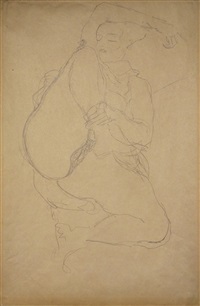Gustav Klimt
(Austrian, 1862–1918)
Biography
Gustav Klimt was an Austrian artist whose patterned paintings came to define the Art Nouveau movement in Vienna. A master of symbolism, Klimt often depicted the female body in a sensual way in his jewel-toned paintings, prints, and drawings as shown in Danae (1907). The artist also painted ornate square-format landscapes, such as Bauerngarten (1907), as well as mythical depictions of nature in The Tree of Life (1905) using gold leaf and alternating blocks of color. Born on July 14, 1862 in Baumgarten, Austria, Klimt studied at the Staatliche Kunstgewerbescule as an architectural painter and opened his own studio soon after. A founding member of the Vienna Secession, Klimt’s artistic practice included commissioned murals, interior décor, and easel painting. A consummate draughtsman, later in life he produced many explicitly erotic drawings—many of which were never seen or exhibited until after his death. A fixture in his city’s art scene, and a profound influence on the younger artist Egon Schiele, Klimt died of Spanish influenza at the age of 56 on February 6, 1918 in Vienna, Austria. In 2003, Klimt’s work broke previous auction records when his portrait of Adele Bloch-Bauer I (1907) was sold at auction for $135 million. Today his paintings and drawings are held in the collections of the Österreichische Galerie Belvedere in Vienna, The Museum of Modern Art in New York, the Musée d’Orsay, the Tate Gallery in London, and the Neue Pinakothek in Munich, among others.

Gustav Klimt
Inclined Male Head to the Right, Head Study..., 1916
Galerie Bei Der Albertina, Zetter GmbH
Price on Request

Gustav Klimt
Undressed and Dressed Women Standing to the..., 1907
Galerie Bei Der Albertina, Zetter GmbH
Price on Request

.jpg)
.jpg)
.jpg)
.jpg)
.jpg)
.jpg)
.jpg)
.jpg)
.jpg)












